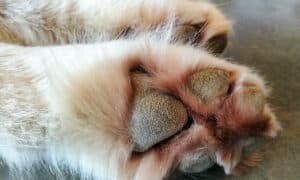“This post contains affiliate links, and I will be compensated if you make a purchase after clicking on my links.”
What in the world is canine bloat? Normally found in larger breeds this condition is a build-up of gas in the stomach of your dog who is unable to pass this gas, and causes bloating of the stomach. It can quickly become a deadly problem. Cancer is the number one cause of death for dogs, but bloating of the stomach is the second leading cause of death.
Canine bloat
Canine bloat is the building of unreleased gas in the dog’s stomach when the stomach begins to twist from 180 to a complete 360 degree rotation at the entrance or esophagus, and at the duodenum or exit of the dog’s stomach leading to the intestines and bowels. This twisting closes off the entrance and exit points leading to gas build-up. The dog is unable to release the gas and if untreated he or she will die. The cause for this condition has yet to be determined. Current studies have concluded the condition is brought on by a dog drinking and eating in excessive amounts and then engaging in strenuous exercise. This results in the food and water becoming gaseous.
The condition is fatal in extreme cases with the dog going into shock, and then a coma, and then death. Not a very pretty thought, so what can we as responsible dog owners do to protect our wonderful pets from this awful condition? Knowing what we can do is where we start to prevent canine bloat. First, keep your dog as free of stress as possible, elevate the food or water bowls, feed your dog smaller amounts of food two to four times a day, Do not allow them to drink water quickly right after eating, take their food away if they begin to gulp their food as fast as they can, and add a quality enzyme to their food to speed digestion. Your vet can recommend what product is best suited to your breed and the dog’s condition.
Here are some symptoms to watch for, according to Pets.WebMD.com:
The classic signs of bloat are restlessness and pacing, salivation, retching, unproductive attempts to vomit, and enlargement of the abdomen. The dog may whine or groan when you press on his belly. Thumping the abdomen produces a hollow sound.
Unfortunately, not all cases of bloat present with typical signs. In early bloat the dog may not appear distended, but the abdomen usually feels slightly tight. The dog appears lethargic, obviously uncomfortable, walks in a stiff-legged fashion, hangs his head, but may not look extremely anxious or distressed.
If your otherwise healthy dog starts developing some of the above symptoms, don’t take a chance: get it to a vet immediately.
Large breeds are most susceptible but this can affect smaller breeds as well as puppies in rare instances.
Breeds most likely to suffer canine bloat include Dobermans, Great Danes, German Shepherds, Bloodhound, Golden Retrievers, Irish Setter, Irish Sheepdog, Boxer, Newfoundland, Labrador Retriever, Old English Sheepdog, Rottweiler, Akita, and Standard Poodle.
How can you lessen the chances of your dog getting dog bloat? Sadly, it is quite difficult as there can be many causes and symptoms. If you suspect your dog has canine bloat quickly get the dog to your vet for diagnosis and treatment.
Have you had a dog with this problem? Please share this article with other dog owners.


















Dr. Chris Smith
says:A study by Purdue University has suggested that feeding from an elevated food bowl INCREASES the risk of GDV (bloat). It is likely that this is a minor factor. More important factors are eating once daily, eating rapidly, exercise after eating and drinking, being underweight, having a “nervous” temperament and of course breed. Deep chested dogs are most at risk. Risk also increases with age.
In my emergency practice, we see this condition at least once every 2 weeks but sometimes twice in one day.
My apologies — USE an elevated bowl. That one got by me when I proofed the article. It has been corrected.
I would add that using a “bloat bowl” is a great, inexpensive preventative measure to help avoid bloat. It’s basically a bowl with a post in the middle that stops the dog from eating his food as fast as he can. Bought mine on Amazon for my 1 year old Malamute, and it dramatically slows his eating. Ounce of prevention and all that.
Pam Denbow
says:Our 4 year old Weimaraner bloated and we were lucky to recognize the symptoms and get her to the ER in 15 minutes where they didn’t hesitate to preform the surgery of untwisting everything and tacking her stomach. I too thought elevating her food and water was best…..so I would also like to know what is the best for her to prevent this from happening again.
Bonnie Kramer
says:I, too, experienced the bloat with our 7 year old standard poodle. Thankfully, we recognized the signs of his distress, and the emergency vet. saved his life and tacked his stomach so that it would’t happen again. I always had elevated bowls for our big dogs. Is this wrong? BTW- our standard who bloated never ate fast, but he went out for a big walk after drinking a lot of water. We never exercise after eating or drinking now.
also read the food bowls should be elevated so they are not eating at floor level. so which is correct.
Ann
says:Mine’s a tall dog, if I don’t elevate his dish, he lies on the floor to eat it. He doens’t gulp, he chews it up. So now I have to worry about this too? What is the percentage of dogs this happens to?
Kare
says:I,too,have read that an elevated dish is better…that the dog doesn’t gulp as much air.
Stephanie
says:I have always heard that large breed dogs should have their food bowls elevated. Who is correct?